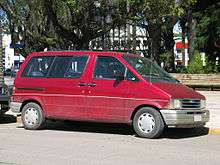Ford Carousel
| Ford Carousel | |
|---|---|
| Overview | |
| Manufacturer | Ford |
| Also called | Ford Carrousel |
| Production | 1973 (prototype only) |
| Model years | N/A |
| Designer | Dick Nesbitt |
| Body and chassis | |
| Class |
|
| Body style | 3-door minivan |
| Layout | FR layout |
| Platform | Ford VN platform |
| Related | Ford Econoline (1975-1991) |
| Powertrain | |
| Engine | 460 cubic inches (7.5 L) V8 |
| Transmission | 3-speed Ford C6 automatic |
| Dimensions | |
| Wheelbase | 124.0 inches (3,149.6 mm) |
The Ford Carousel (also spelled Carrousel[1]) is a prototype vehicle that was developed by Ford in 1973.[2] It was designed and styled by Dick Nesbitt, designer of the Ford Mustang II.[3] The Carousel/Carrousel was assembled by Carron & Company of Inkster, Michigan.[4]
While never produced, the Carousel explored many of the concepts that would be seen a decade later in minivans produced by American automakers including two-box design, garageable height, and three-row seating as an alternative to both station wagons and full-size vans.
Development
In 1972, Ford truck designers had started to finish design work on a full-sized van project. Codenamed "Nantucket", it would become the 1975 Ford Econoline/Club Wagon in its final form.[5] While boasting more usable interior space for driver and front passengers, the new Econoline had become a close fit in the average American garage door opening. In 1972, Ford president Lee Iaccoca approved development of a variant based on the Nantucket project. Codenamed "Carousel", the variant was to be a "garageable van".[5][6][7] If approved for production, its target market would have been both buyers of full-size station wagons and passenger van buyers.[1][7]
Sharing the frame of the short-wheelbase model,[4] Carousel was designed with a lower roofline than the full-size Econoline. Underneath the hood, Ford fitted it with a 460 cubic-inch V8, sourced from the Lincoln Continental Mark III .[4] As its primary market was retail buyers, the rear body of the Carousel was surrounded in glass (in a style not unlike the 1950s Chevrolet Nomad). To attract wagon buyers, the rear door was a tailgate with a retracting rear window.[3] To further attract wagon buyers, the Carousel prototype was built to the equivalent of a potential "Squire" trim level; the body was fitted with simulated woodgrain siding.[3]
Inside, the seating arrangement of the Carousel mimicked that of the Club Wagon; two captains' chairs with two bench seats.[3] While based on the Econoline, the Carousel prototype wore its own instrument panel and was trimmed similar to the LTD Brougham and Thunderbird[1][4] (at the time, this would have placed the Carousel above the LTD Country Squire in the Ford station wagon lineup).
Fate
Cancellation
In 1973, the Carousel had been fabricated into a running prototype ready for production approval, potentially for a 1975 launch. Inside of Ford, the Carousel had won a great deal of support, including that of Henry Ford II.[1] However, it faced internal opposition from other Ford executives, who feared such a vehicle would have potentially threatened sales of the (highly profitable) Ford LTD Country Squire and Mercury Colony Park.[4]
After the 1973 energy crisis and the recession of the mid 1970s, the company was forced to cut back on new vehicle development. As the Carousel was not a direct replacement for any existing Ford vehicle, it was shelved.[1]
In 1978, Lee Iacocca was fired from Ford; several months later, Director of Product Planning Hal Sperlich also left the company. Soon after, both were hired in similar roles at Chrysler Corporation. This would lead to the development of the Chrysler minivans for the 1984 model year. While much different in their use of front-wheel drive, unit-body construction, they followed the two-box design of the Carousel; additionally, they were marketed as family vehicles with smaller garage footprints than full-size wagons.
Ford Aerostar

At the same time Chrysler commenced minivan production, Ford revisited the idea of a garageable van for the first time. In 1984, the company revealed the Aerostar; much like the Carousel, it was a prototype of an intended production vehicle. In mid-1985, the Aerostar commenced sales in production form.
While fuel economy had been a key factor in the cancellation of the Carousel, it would play a key role in the design of the Aerostar. While based on its own frame, the Aerostar would be designed to share many components with the Ranger compact pickup truck; a stillborn option was a diesel 4-cylinder engine. Foregoing a two-box design, the hood was sloped at nearly the same angle as the windshield.
After the 1997 model year, the Aerostar was discontinued; Ford had largely replaced it in 1995 with the Windstar. The Windstar would largely follow the design set in place by Chrysler, adopting front-wheel drive and unit-body construction based on a car platform.
References
- 1 2 3 4 5 http://vehiclevoice.com/tag/ford-carousel/
- ↑ http://vehiclevoice.com/2007/07/ford_carrousel_story_continues_1/#more-787
- 1 2 3 4 http://auto.howstuffworks.com/1972-ford-carousel-minivan-concept-car2.htm
- 1 2 3 4 5 "Yarn – Nobody Ever Talks About Ford's Carrousel Concept". Retrieved 28 November 2013.
- 1 2 http://www.thetruthaboutcars.com/2010/03/1972-ford-carousel-the-chrysler-minivans-true-father/#more-350855
- ↑ http://auto.howstuffworks.com/1972-ford-carousel-minivan-concept-car1.htm
- 1 2 http://www.thetruthaboutcars.com/2010/03/1972-ford-carousel-the-chrysler-minivans-true-father/
| ||||||||||||||||||